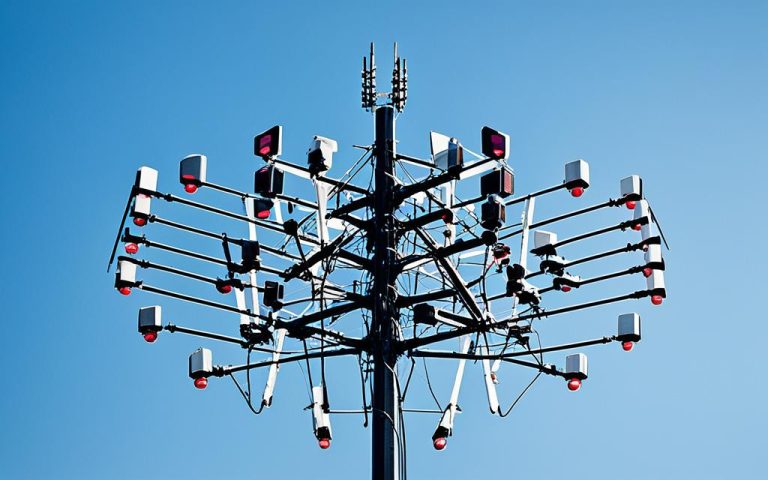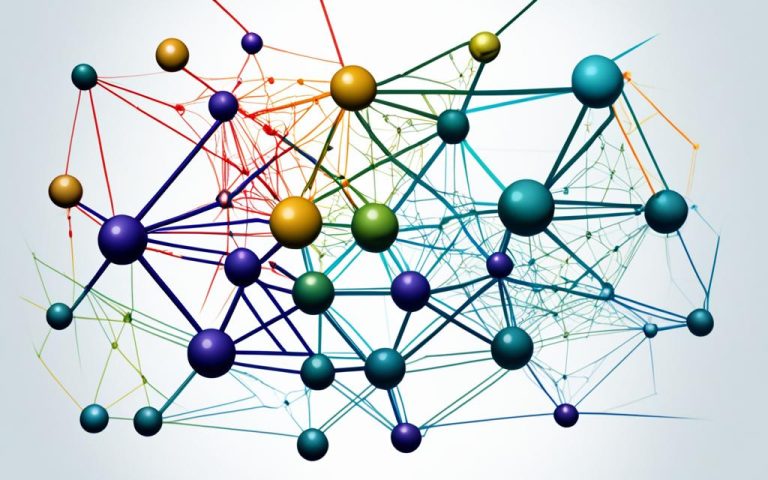Interference management is a crucial aspect of optimizing spectrum efficiency in today’s fixed wireless networks. To address this challenge, two emerging paradigms have gained prominence: interference shaping and interference exploitation. These techniques aim to minimize the impact of interference and maximize data rates in interference-limited communication scenarios.
In this section, we will explore the strategies and techniques associated with interference shaping and exploitation in single-hop, multi-hop, and multi-way network architectures. By implementing these approaches, network administrators can enhance performance and ensure robust connectivity in fixed wireless networks.
Interference management plays a crucial role in improving spectrum efficiency in current and next-generation wireless systems. Two emerging paradigms for interference management are interference shaping and interference exploitation. Interference shaping aims to minimize the aggregated interference effect at each receiver by creating a specific interference pattern, while interference exploitation harnesses interference as side-information to increase data rates.
These techniques offer better performance in interference-limited communication regimes. This section provides an overview of interference management strategies using interference shaping and exploitation techniques in single-hop, multi-hop, and multi-way network architectures.
Stay tuned to learn more about how interference shaping and exploitation can revolutionize interference management in fixed wireless networks.
Interference Management in Single-Hop Networks
Interference management in single-hop networks, such as cellular and wireless local area networks (WLANs), presents significant challenges due to the need for effective control of transmitted signals’ propagation to unattended receivers. In order to minimize interference and enable interference-free decoding, interference alignment and interference shaping techniques play a crucial role.
Interference alignment is a powerful technique that aligns multiple interfering signals at each receiver, allowing for interference cancellation and ultimately reducing the overall interference level. This technique involves optimizing the transmit strategy to align the interference signals in a way that they occupy the same subspace as the desired signal, resulting in interference-free decoding.
Interference shaping, on the other hand, focuses on minimizing or eliminating the aggregated interference effect at each receiver. By carefully designing the transmission and reception schemes, interference shaping techniques aim to create a specific interference pattern that reduces the impact of interference on the desired signal.
Both interference alignment and interference shaping techniques have their own benefits and practical challenges. Interference alignment provides effective interference cancellation and significantly improves the capacity of the network, but its implementation requires extensive knowledge of the network’s characteristics and channel state information. Interference shaping, on the other hand, offers a more practical approach that can be easily implemented in real-world scenarios, but its performance may be limited compared to interference alignment.
It is essential for researchers and network designers to explore and evaluate the concepts of interference alignment and shaping in single-hop networks to determine the most suitable approach for managing interference effectively.
Overall, interference management in single-hop networks is a complex task that requires careful consideration of various factors such as channel conditions, network topology, and desired performance objectives. By employing interference alignment and interference shaping techniques, network operators can mitigate interference and optimize the overall performance of their wireless networks.
Benefits of Interference Alignment and Interference Shaping in Single-Hop Networks:
- Improved data rates and capacity
- Enhanced interference cancellation
- Reduced interference impact on desired signals
- Flexibility in managing interference
“Interference alignment and interference shaping techniques offer significant advantages in managing interference in single-hop networks, enabling higher data rates, enhanced capacity, and improved overall network performance.”
Interference Management in Multi-Hop Networks
Interference management in multi-hop networks presents unique challenges due to the large-scale, dynamic, and decentralized nature of these operations. To address interference in such networks, various mitigation techniques are employed, including collision-based interference models and interference alignment.
While Multi-hop networks allow for communication over long distances by relaying signals through intermediate nodes, they also introduce additional interference sources and complexities. Traditional interference models based on Signal-to-Interference-plus-Noise Ratio (SINR) are not always suitable for multi-hop networks. Instead, collision-based interference models have proven to be more effective in practical applications, as they consider the impact of simultaneous transmissions within interference range.
A collision-based interference model defines that if two transmissions occur simultaneously within the interference range of each other, both transmissions will fail due to interference. This model enables the tractable design of Medium Access Control (MAC) strategies in multi-hop networks.
Interference mitigation techniques such as power control and interference alignment are utilized to reduce interference in multi-hop networks. Power control involves adjusting transmit power levels to mitigate interference and optimize the overall network performance. Interference alignment aims to align interfering signals to improve signal quality at receivers and minimize the impact of interference.
Overcoming interference challenges in multi-hop networks requires a comprehensive understanding of the network topology, interference sources, and the dynamic nature of the environment. By employing collision-based interference models and leveraging interference mitigation techniques, network operators can effectively manage and minimize interference, enhancing the performance and reliability of multi-hop networks.
Inset Image:

Interference Management in Fixed Wireless Networks
Interference in fixed wireless networks can arise from various sources, including other wireless devices like baby monitors, security cameras, and microwaves. Mitigating this interference is crucial in ensuring optimal network performance and user experience. One effective method to identify and manage interference is by conducting a comprehensive Wi-Fi survey using professional surveying software.
A Wi-Fi survey allows network administrators to visualize the wireless spectrum and detect interference sources that may hinder network performance. By analyzing signal, noise, and signal-to-noise ratio (SNR) data, administrators can gain insights into the quality of the wireless signals and identify potential areas of improvement. This detailed analysis enables the identification of specific interference sources affecting the network.
To further optimize network performance, it is essential to eliminate interference caused by one’s own access points (APs). Properly configuring the APs and ensuring a balanced coverage overlap can reduce interference and enhance network capacity. By strategically placing and configuring access points, administrators can create a more reliable and interference-free network environment.
| Interference Source | Impact on Network |
|---|---|
| Wireless Devices (e.g., baby monitors, security cameras, microwaves) | Increased noise and signal degradation |
| Adjacent APs with Overlapping Coverage | Co-channel interference and decreased network performance |
Another key strategy to mitigate interference in fixed wireless networks is to make effective use of the 5 GHz band. The 5 GHz band offers more available channels and less interference compared to the crowded 2.4 GHz band. Moving more clients to the 5 GHz band can significantly reduce interference and congestion, resulting in improved network performance and higher data rates.
In conclusion, managing interference in fixed wireless networks is crucial for optimizing network performance and ensuring a seamless user experience. Conducting Wi-Fi surveys, eliminating interference from APs, and utilizing the less congested 5 GHz band are effective techniques to mitigate interference and improve network efficiency.
Conclusion
Effective interference management plays a crucial role in ensuring robust connectivity and peak performance in fixed wireless networks. Interference shaping and interference exploitation techniques offer improved performance in interference-limited communication regimes. By implementing interference management strategies such as interference alignment, interference shaping, collision-based interference models, and utilizing spectrum analysis tools, network administrators can effectively mitigate interference and optimize network performance.
Continued research and innovation in interference management will be essential to address practical challenges and advance the field of fixed wireless networks. As the demand for wireless connectivity continues to grow, it becomes increasingly important to develop effective interference mitigation techniques to ensure reliable and efficient network operations.
By considering factors such as interference sources, spectrum allocation, and network configurations, network administrators can make informed decisions to minimize interference and maximize the performance of fixed wireless networks. Moving forward, collaboration between researchers, industry experts, and regulatory bodies will be vital to drive the development and adoption of interference management solutions for the benefit of network operators and end-users alike.
FAQ
What is interference management?
Interference management involves strategies and techniques aimed at reducing or minimizing the impact of interference on wireless communication systems, improving performance and spectrum efficiency.
How does interference shaping work?
Interference shaping is a technique that aims to minimize the aggregated interference effect at each receiver by creating specific interference patterns, allowing for interference-free decoding and improved data rates.
What is interference alignment?
Interference alignment is a technique used in single-hop networks that aligns multiple interfering signals at each receiver to minimize interference, enabling interference-free decoding.
What are collision-based interference models?
Collision-based interference models are often used in multi-hop network design. These models consider that simultaneous transmissions within interference range of each other collide, resulting in a failure of both transmissions.
How can interference be mitigated in multi-hop networks?
Techniques such as power control and interference alignment are employed in multi-hop networks to reduce interference, ensuring better performance and connectivity in these complex network architectures.
How can interference be managed in fixed wireless networks?
Conducting a Wi-Fi survey using professional surveying software can help identify interference sources and analyze signal data. Properly configuring access points and utilizing the 5 GHz band can also improve network performance and reduce interference.
What are the benefits of effective interference management in fixed wireless networks?
Effective interference management strategies, such as interference alignment and shaping, can optimize network performance, mitigate interference, and ensure robust connectivity in fixed wireless networks.
Why is research and innovation important in interference management?
Continued research and innovation in interference management are essential to address practical challenges, advance the field, and further optimize network performance in wireless communication systems.



















